Some random bits of Electrodyne kit that I came across… Above, their ACC-1204… looks pretty neat… anyone?
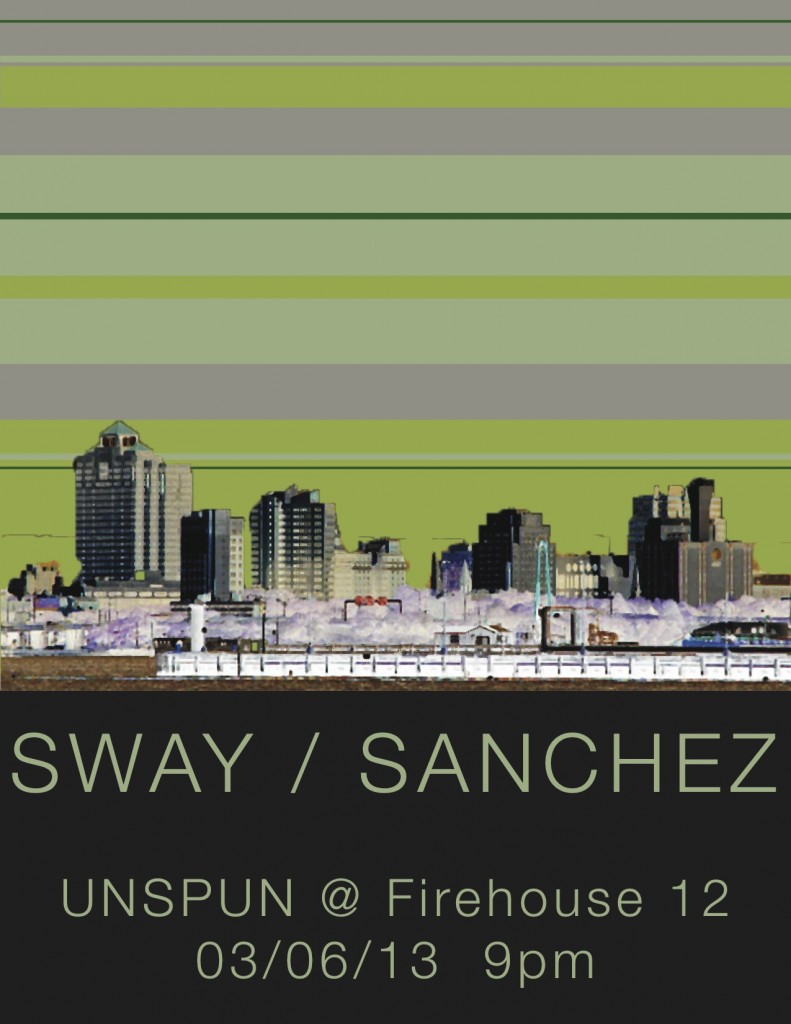 Hello y’all… Once again I will be dusting off ye old 70s soul and punk vinyl at FIREHOUSE 12, New Haven CT, alongside my good old friend JBW aka SWAY… We’re on tomorrow, Wednesday the sixth, from 9PM til one. Come on down to the best bar in CT and hear some (lost)(never were)(prolly should-have-been) classics.
Hello y’all… Once again I will be dusting off ye old 70s soul and punk vinyl at FIREHOUSE 12, New Haven CT, alongside my good old friend JBW aka SWAY… We’re on tomorrow, Wednesday the sixth, from 9PM til one. Come on down to the best bar in CT and hear some (lost)(never were)(prolly should-have-been) classics.
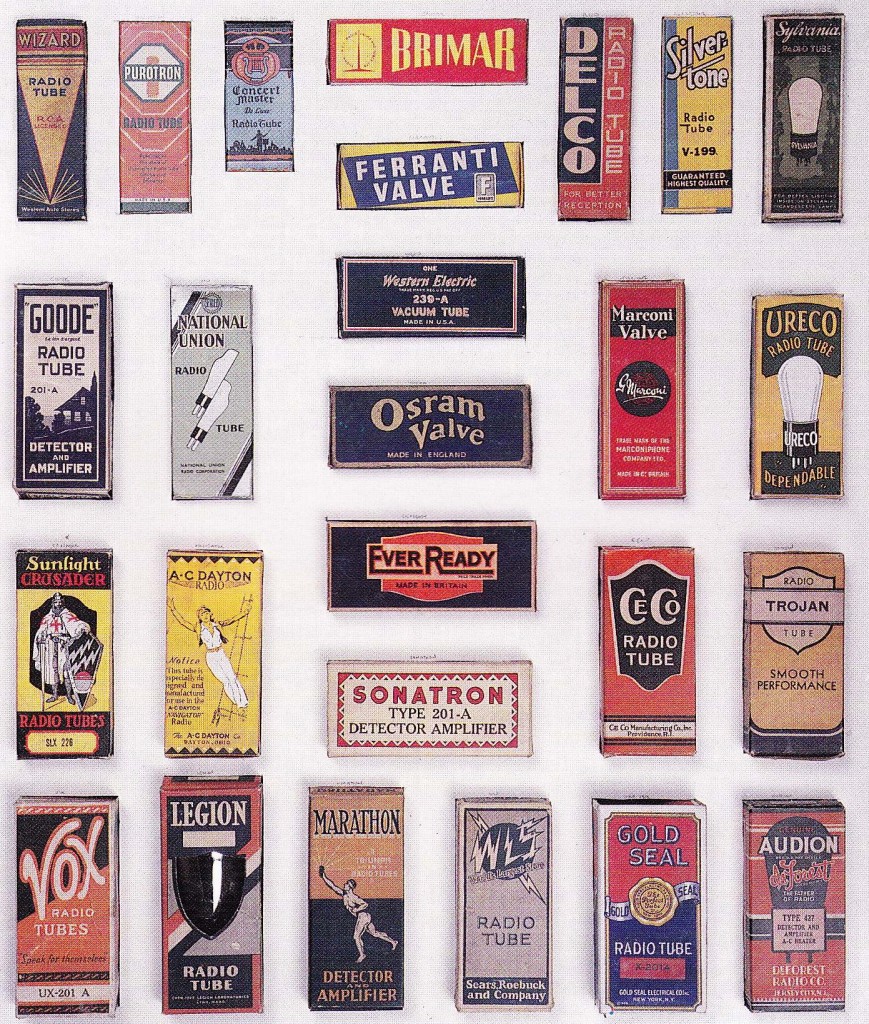 From “The Old Timer’s Bulletin” Vol 33., #1: a short piece on the minor hobby of collecting and displaying antique tube BOXES. Not the tubes, mind you, just the boxes. Fast forward to me in 30 years…
From “The Old Timer’s Bulletin” Vol 33., #1: a short piece on the minor hobby of collecting and displaying antique tube BOXES. Not the tubes, mind you, just the boxes. Fast forward to me in 30 years…
*******
***
I recently bought a huge pile of the old radio fanzines; hundreds, probably, from the family of a deceased collector, likely; and while Old Radios just aren’t ‘my thing,’ the ‘zines are great, really charming+heartfelt lil snapshots of collector-life. The only parallel I have seen in the musical-gear world is Vintage Guitar magazine, which is eh so-so. I have subscribed and unsubscibed to VG a few times now, it’s not bad, and the price is certainly right, but I dunno it just sorta misses the mark… maybe it’s just too dry… Anyhow, in this era of online-everything, are there any noteable audio and/or instrument print-fanzines still in production? Anything worth checking out? Let us know…
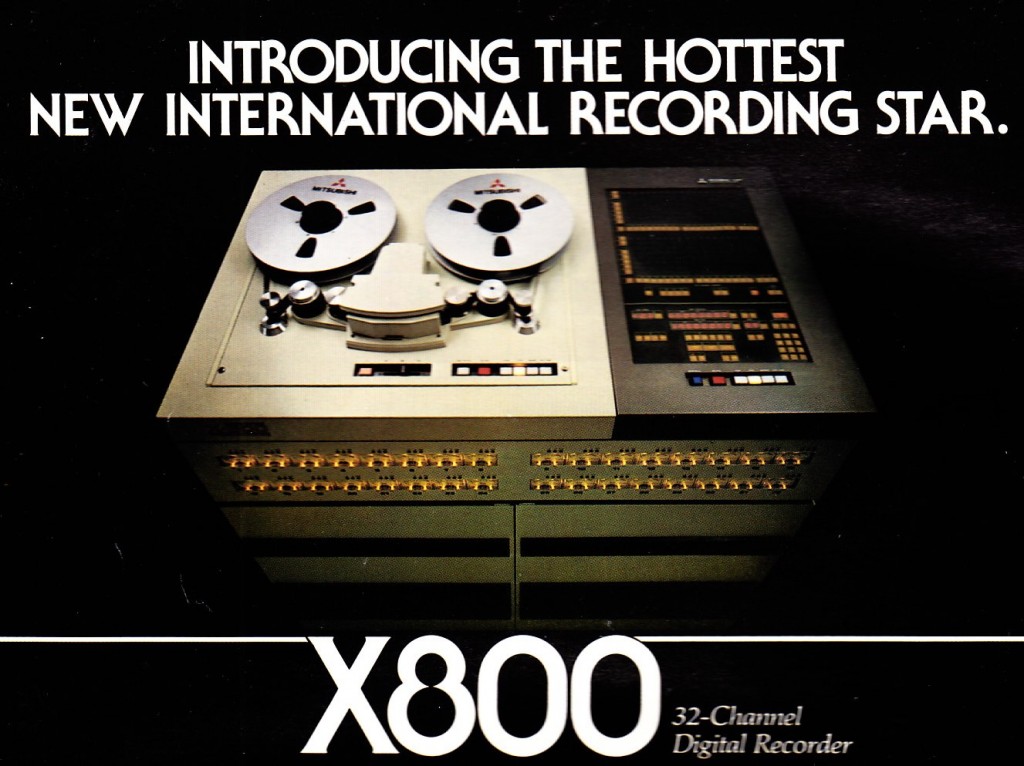 Above: The Mitsubishi X800, an early digital multitrack audio recorder (1980).
Above: The Mitsubishi X800, an early digital multitrack audio recorder (1980).
What better way to end 70’s month at PS dot com than a to take a quick look forward, from the vantage point of 1982, at the new era of digital audio. Below: the very-smart John Woram offers an editorial in DB magazine, 1982, on the new age to come. Although digital multitracking was already widely-used in high-end music production by 1982, that year saw the introduction of the first consumer digital audio playback devices, the CD player. For the first time, the cycle could be complete: you, as the consumer, could hear exactly (well, speakers and room acoustics notwithstanding) what the producer heard in the mastering suite. Audio, which had been a chimerical, elusive magnetic or physical/mechanical fluctuation for over 100 years had been successfully reduced to an (at least acceptable) data stream. Let’s see what Woram had to say…
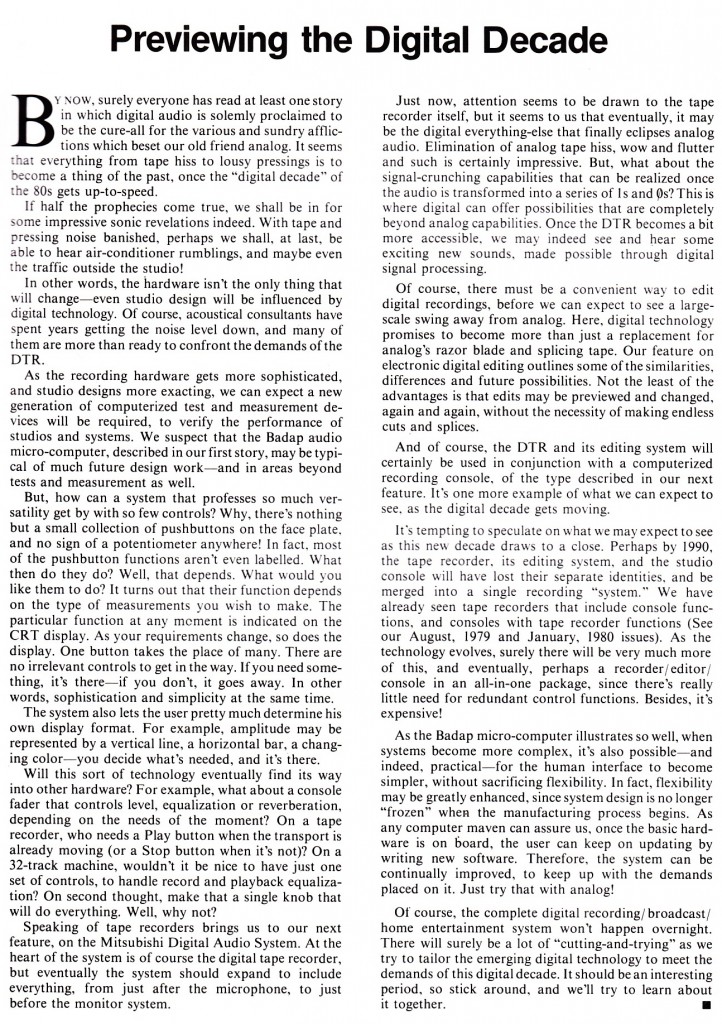 It’s not an easy thing to imagine the future. I see this in practice every year with my Visual Semiotics students when I issue an assignment that requires them to re-create a current print advert as it might appear 50 years from now. The students who manage to do it successfully are able to grasp that both the technology and the aesthetics of the culture will shift, and that these shifts need to be related in some fundamental way. Of course, they could still end up being very wrong about the particular outcome; only time will tell. But a relationship between tools, technique, and form is fundamental to human endeavor. Woram seems to have very accurately predicted the state of professional audio circa 1995 or so. It’s now 2013. Where will be be in twenty years?
It’s not an easy thing to imagine the future. I see this in practice every year with my Visual Semiotics students when I issue an assignment that requires them to re-create a current print advert as it might appear 50 years from now. The students who manage to do it successfully are able to grasp that both the technology and the aesthetics of the culture will shift, and that these shifts need to be related in some fundamental way. Of course, they could still end up being very wrong about the particular outcome; only time will tell. But a relationship between tools, technique, and form is fundamental to human endeavor. Woram seems to have very accurately predicted the state of professional audio circa 1995 or so. It’s now 2013. Where will be be in twenty years?
Back to that Mitsu’ pictured at the head of the article. Anecdotal information that I gleaned from engineers I have worked with over the years had somehow created the impression that these machines marked the introduction of widespread digital multitracking, and my admittedly cursory research seemed to confirm that. T. Fine wrote in to offer a more detailed account based on his ARSC article published in 2008. Click here to read the complete article entitled THE DAWN OF COMMERCIAL DIGITAL RECORDING. Fine:
“The first widely-used digital multitrack system was 3M’s, at first by Warner Brothers’ studios out in California. Ry Cooder’s “Bop Til You Drop” was the first all-digital rock album, recorded on the 3M system. Many followed including Ricky Lee Jones’ “Pirates” and others. Fleetwood Mac did “Tusk” on the 3M recorder, too. The 3M system was also used by Columbia for classical recordings and by Deutsche Gramophone. Soundstream was the first AMERICAN digital audio recorder, but not the first. Denon had them beat by more than 5 years. All of the early players — Denon, Soundstream and 3M — faded by the mid-80s. RCA was heavily invested in Soundstream and bought most of the remaining equipment when the company went out of business. I don’t know if 3M made 100 total digital recorders. The things cost a fortune.”
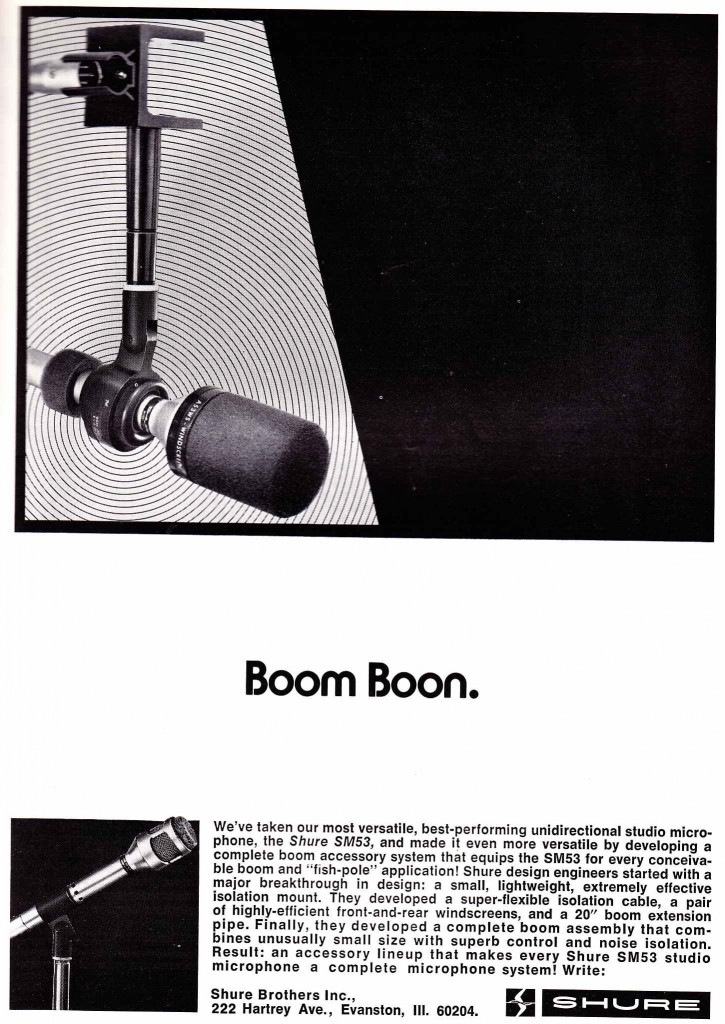 Today at PS dot com: 70’s month nears its close with a quick look at some promising but lesser-known mics of the 70s. If you are using any of these pieces in the studio these days, drop us a line and weigh in. above: the Shure SM53, a high-end dynamic cardiod that seems to maybe have been Shure’s answer to the RE15? I’ve been trying to pick one these up on eBay, no luck yet… anyone?
Today at PS dot com: 70’s month nears its close with a quick look at some promising but lesser-known mics of the 70s. If you are using any of these pieces in the studio these days, drop us a line and weigh in. above: the Shure SM53, a high-end dynamic cardiod that seems to maybe have been Shure’s answer to the RE15? I’ve been trying to pick one these up on eBay, no luck yet… anyone?
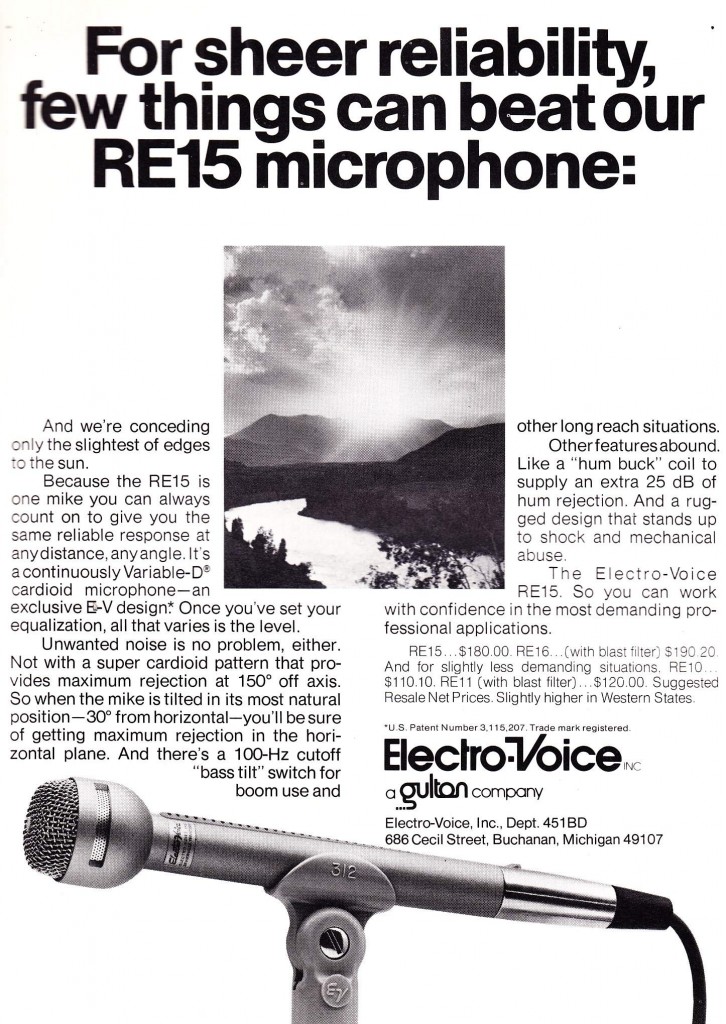 And speaking of the RE15… after watching the prices slowly rise on eBay for the past year, I finally picked up one of these.. expect some audio clips/shoot-out here soon. I always ignored these in the past, i figured, I have an RE20, what’s the point… but I finally had to know. I recently worked with a contractor/tech from a major live-sound company who had 1/2 the stage mic’d with these things, swears by ’em… anyway, I am super-curious. They are apparently very hi-fi with very accurate off-axis response. More to come…
And speaking of the RE15… after watching the prices slowly rise on eBay for the past year, I finally picked up one of these.. expect some audio clips/shoot-out here soon. I always ignored these in the past, i figured, I have an RE20, what’s the point… but I finally had to know. I recently worked with a contractor/tech from a major live-sound company who had 1/2 the stage mic’d with these things, swears by ’em… anyway, I am super-curious. They are apparently very hi-fi with very accurate off-axis response. More to come…
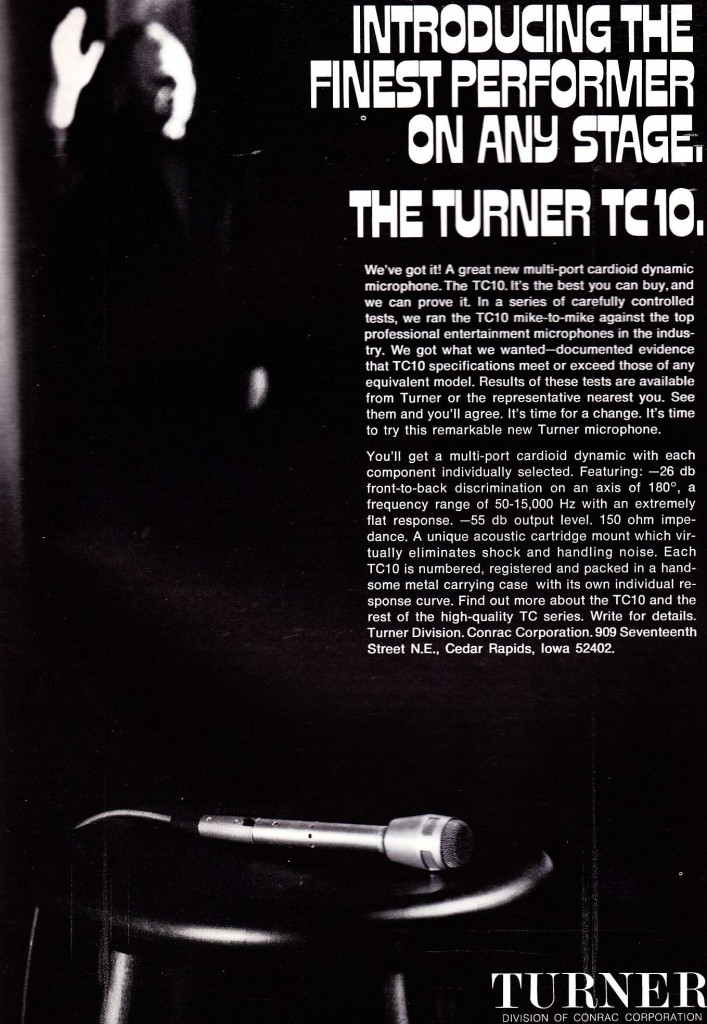 While on the subject of dynamic mics… above, the Turner Model 10 circa 1972. Those of you who’ve been following PS for a while will know that I am a big fan of obscure Turner models, especially the flagship models like the 510… I recently bought my second 510 for Gold Coast Recorders and I have to sadly report that it is not as awesome as the example I have had for years… Anyway, the Model 10 seems to have been a replacement for the 500/510 series… there is a super-rare Model 11 (likely the ‘selected’ hi-fi version of the Model 10) on eBay right now for really cheap… might be a good purchase for anyone looking for more interesting dynmics mics…
While on the subject of dynamic mics… above, the Turner Model 10 circa 1972. Those of you who’ve been following PS for a while will know that I am a big fan of obscure Turner models, especially the flagship models like the 510… I recently bought my second 510 for Gold Coast Recorders and I have to sadly report that it is not as awesome as the example I have had for years… Anyway, the Model 10 seems to have been a replacement for the 500/510 series… there is a super-rare Model 11 (likely the ‘selected’ hi-fi version of the Model 10) on eBay right now for really cheap… might be a good purchase for anyone looking for more interesting dynmics mics…
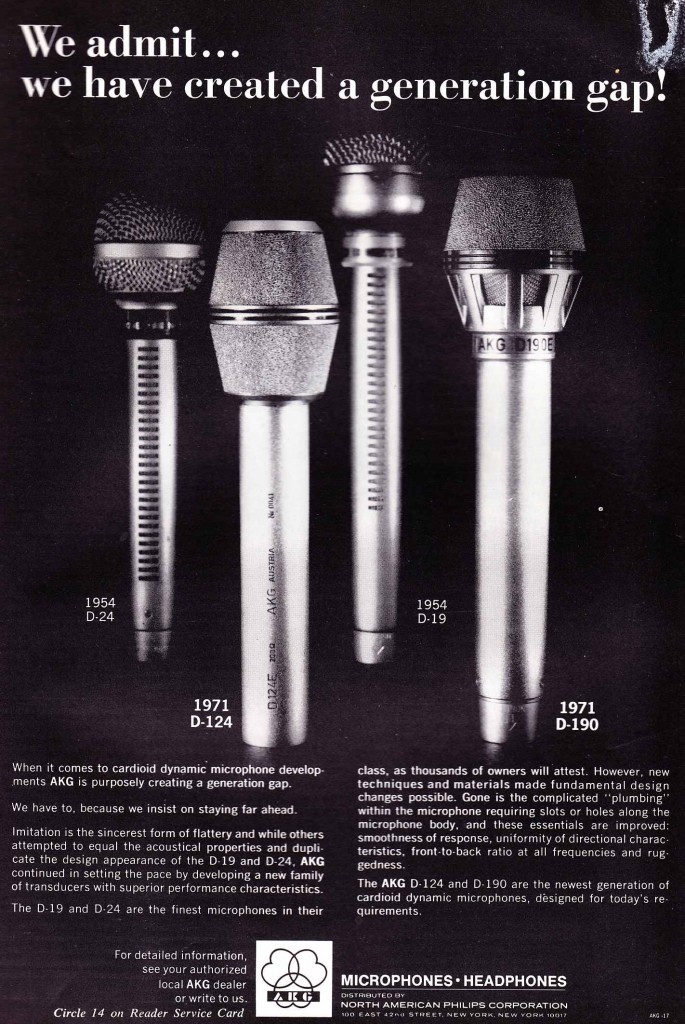 Above, the AKG D190 and D124! Finally some info on the D124… these turn up in my old 70s AKG catalogs (most of which you can download here on PS dot com), and I actually use this as the console talkback mic at GCR, but I had not realized that it was the replacement for the D-24. The D-124 is an amazing little piece of engineering, very nice smooth sound and incredibly small in size. D-190s are much more common, I tend to see these on CRList quite often.
Above, the AKG D190 and D124! Finally some info on the D124… these turn up in my old 70s AKG catalogs (most of which you can download here on PS dot com), and I actually use this as the console talkback mic at GCR, but I had not realized that it was the replacement for the D-24. The D-124 is an amazing little piece of engineering, very nice smooth sound and incredibly small in size. D-190s are much more common, I tend to see these on CRList quite often.
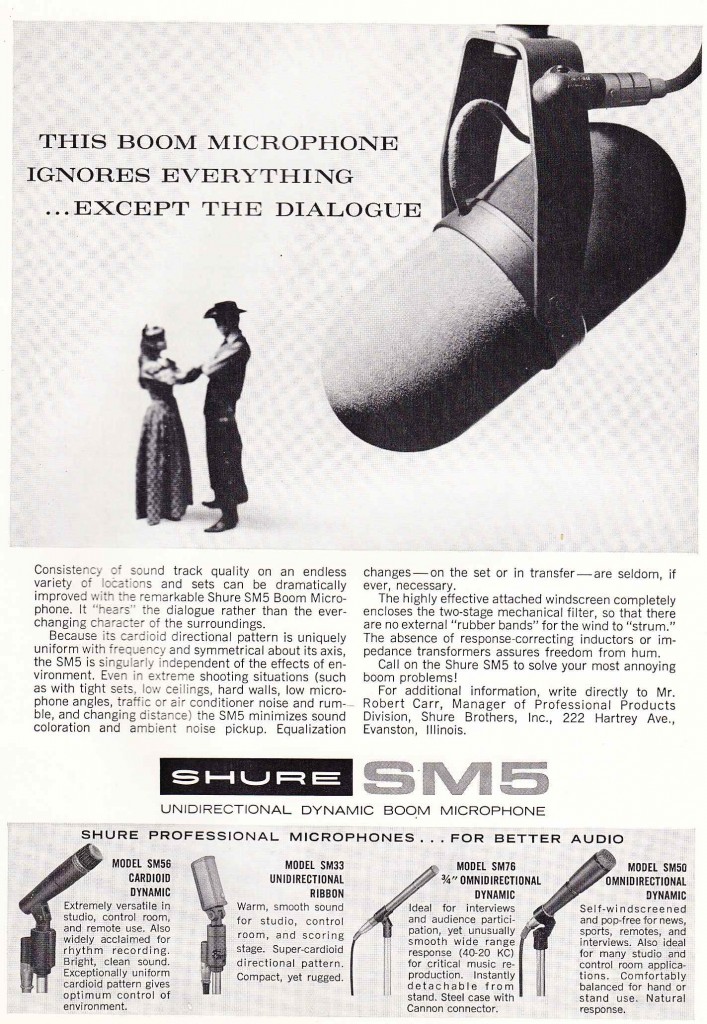 Above: Shure SM5 circa 1969. I love the similar SM7, use it regularly, it seems to have become somewhat of a standard-bearer vocal mic these days… artists actually ask for it in the studio the same way some will ask for an 87 or 47 or 58…. The SM5 is much less common, no longer made, and consequently extremely expensive. Are any of y’all using SM5s for music or vocal recording these days? Thoughts?
Above: Shure SM5 circa 1969. I love the similar SM7, use it regularly, it seems to have become somewhat of a standard-bearer vocal mic these days… artists actually ask for it in the studio the same way some will ask for an 87 or 47 or 58…. The SM5 is much less common, no longer made, and consequently extremely expensive. Are any of y’all using SM5s for music or vocal recording these days? Thoughts?
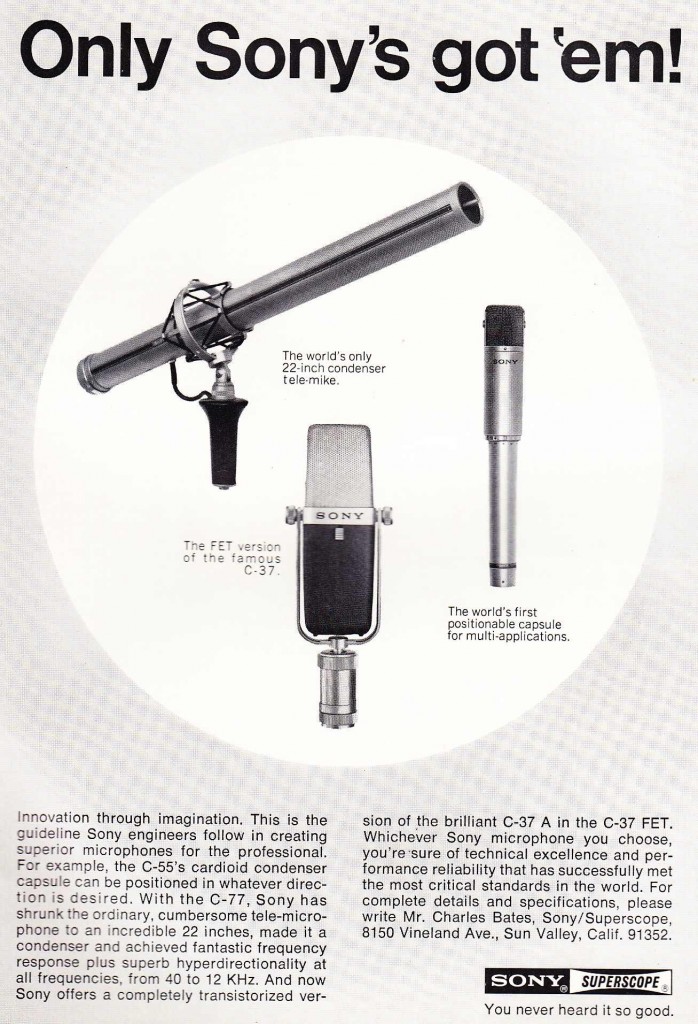 Above: Sony ‘Superscope’ branded C-77, C-37, and C-55 circa 1969. A C-37 or C-37 Fet is very high on my wish-list… Never used any of these models.. anyone?
Above: Sony ‘Superscope’ branded C-77, C-37, and C-55 circa 1969. A C-37 or C-37 Fet is very high on my wish-list… Never used any of these models.. anyone?
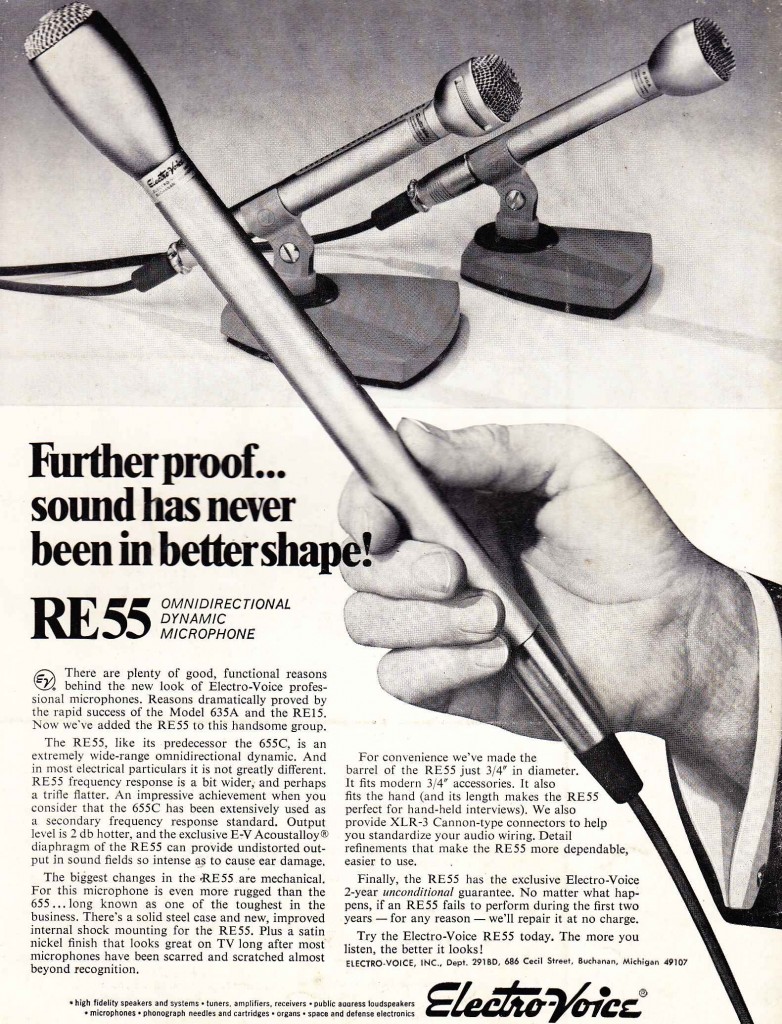 Above: the Electrovoice RE55 is introduced (1969). Interesting to see that the RE55 was the successor to the 655. I have a pair of 655 at GCR, very very old pair circa 1950, and wow they sound great. Fairly high self-noise for a dynamic, but for drum overheads it’s never a problem. Anyone using the RE55? Seem pretty uncommon…
Above: the Electrovoice RE55 is introduced (1969). Interesting to see that the RE55 was the successor to the 655. I have a pair of 655 at GCR, very very old pair circa 1950, and wow they sound great. Fairly high self-noise for a dynamic, but for drum overheads it’s never a problem. Anyone using the RE55? Seem pretty uncommon…
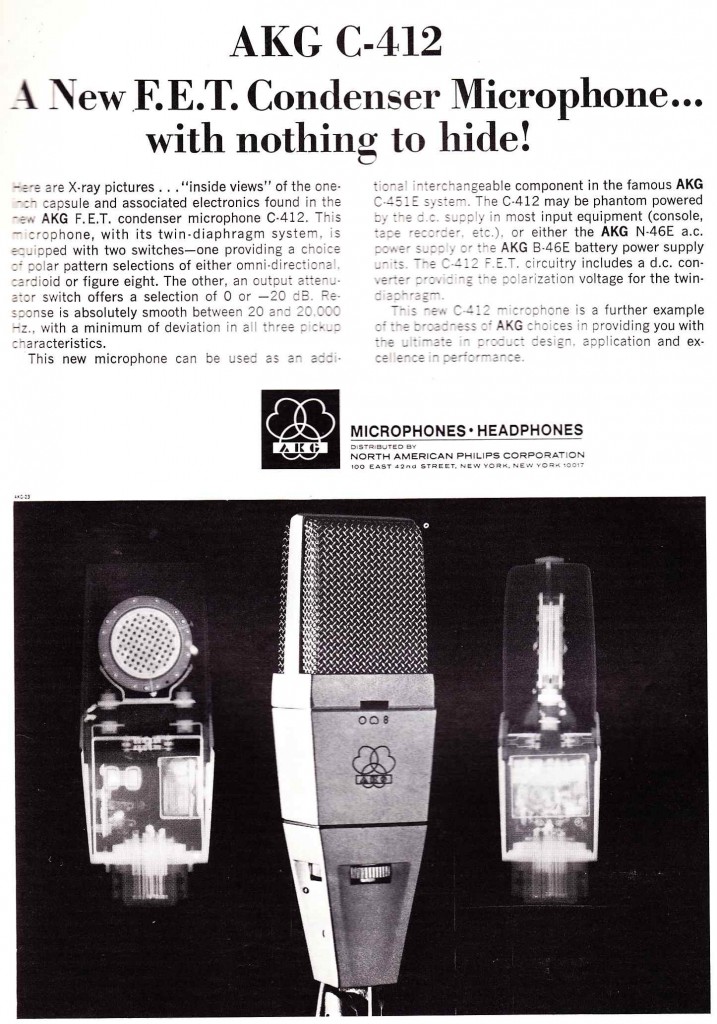 Above: The AKG 412 circa 1972. Seems to be the final evolution of the C12 prior to introduction of the still-standard 414. Anyone using a 412? Is it significantly different than a circa 70s 414?
Above: The AKG 412 circa 1972. Seems to be the final evolution of the C12 prior to introduction of the still-standard 414. Anyone using a 412? Is it significantly different than a circa 70s 414?
 From DB Mag, sometime mid seventies: a really fascinating discussion of something that I would have guessed was impossible: completely electro-mechanical automated audio time compression/expansion. As-in: changing the run time of an audio recording without changing the pitch. The article was written by one Sidney Silver, who was the recording/audio director of the telecom division of the UN. I feel like this could make an amazing-sounding plug-in if someone took the time to digitally model it.
From DB Mag, sometime mid seventies: a really fascinating discussion of something that I would have guessed was impossible: completely electro-mechanical automated audio time compression/expansion. As-in: changing the run time of an audio recording without changing the pitch. The article was written by one Sidney Silver, who was the recording/audio director of the telecom division of the UN. I feel like this could make an amazing-sounding plug-in if someone took the time to digitally model it.
Here is a June 1958 press announcement for Springer’s device, compete with photograph. The price in 1955 was $1900 ($14,000 in 2013 dollars) (SOURCE)
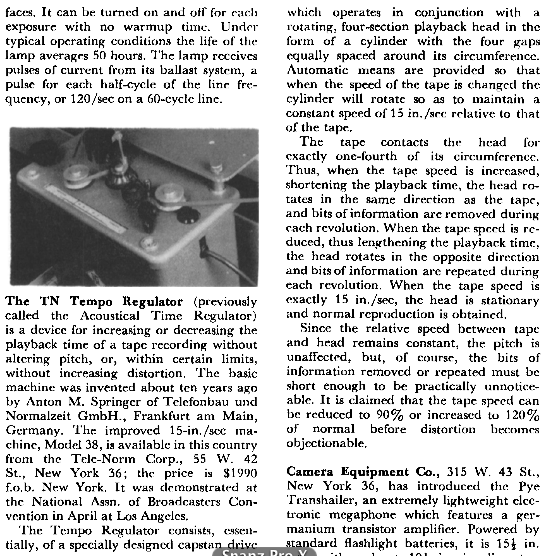 Do any of these ‘Acoustical Time Regulators’ survive? Anyone ever seen one, or heard this system in operation?
Do any of these ‘Acoustical Time Regulators’ survive? Anyone ever seen one, or heard this system in operation?
For more information regarding this technology, click here.
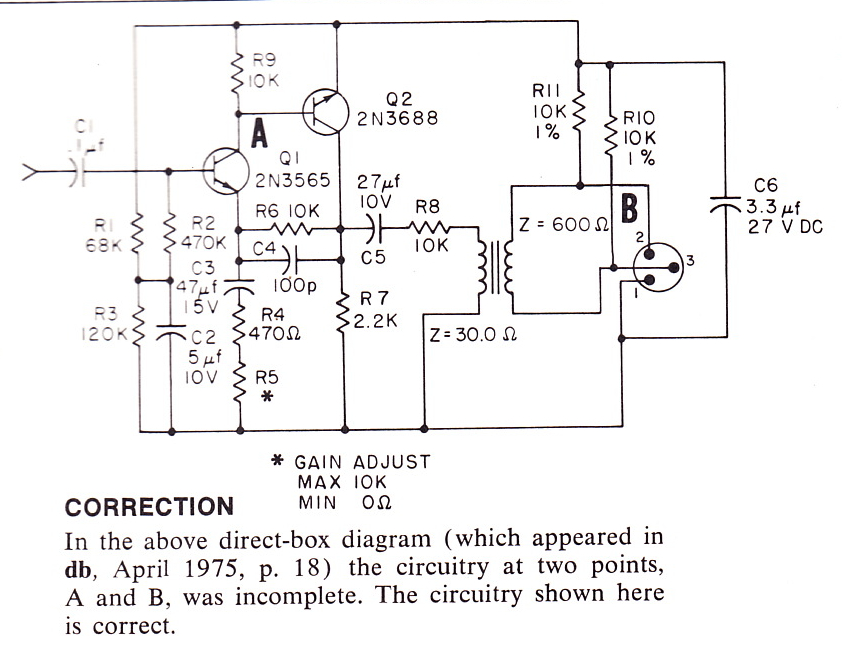 From DB magazine, June 1975: a direct-box that was custom-designed for Leon Russell’s studio. I am a huge LR fan and once I dig up a 30:600 transformer I am gonna throw one together. Question for you solid-state guys: 2N3688 is no longer available; is there a ‘preferred’ substitute? And: 2N3565 seems crazy expensive! $11! is there a cheaper sub?
From DB magazine, June 1975: a direct-box that was custom-designed for Leon Russell’s studio. I am a huge LR fan and once I dig up a 30:600 transformer I am gonna throw one together. Question for you solid-state guys: 2N3688 is no longer available; is there a ‘preferred’ substitute? And: 2N3565 seems crazy expensive! $11! is there a cheaper sub?
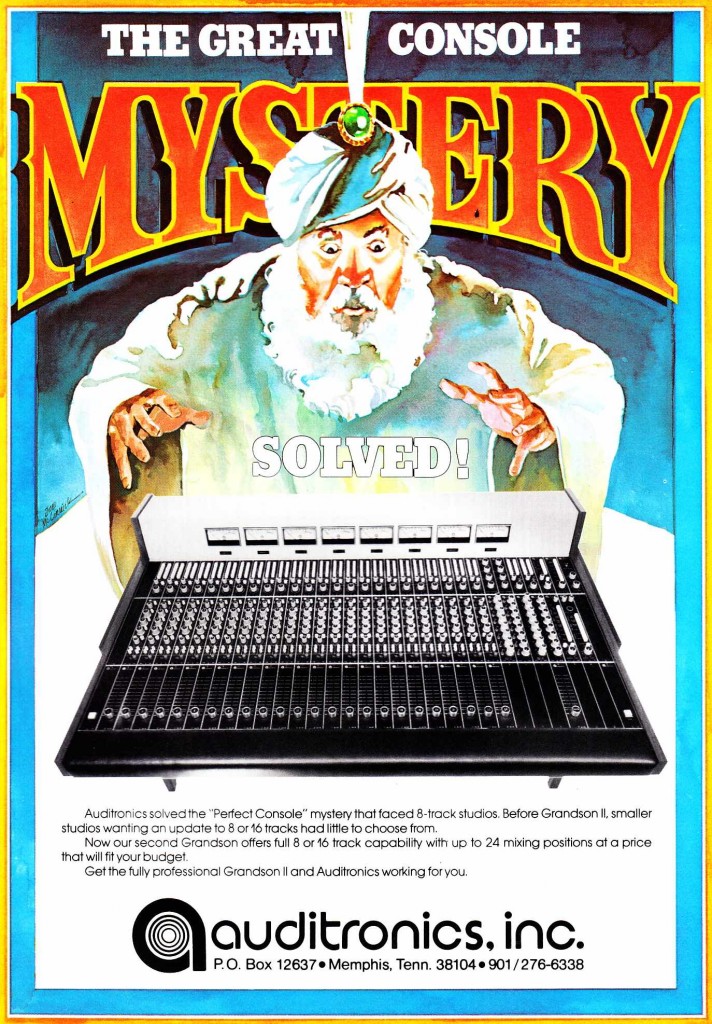 Above: the Audiotronics Grandson II console circa 1975
Above: the Audiotronics Grandson II console circa 1975
Way back in October of 2010 I ran a short piece about some 1970s audio consoles, and now 70s month rolls on with an extensive image gallery of some iconic and some obscure mixing desks from that decade. I’m a hardware mixer fan; I learned audio production in a studio with a Trident Trimix and my brain often just defaults to finding solutions and working-methods that are faster to do with a real console rather than via a DAW. I would never give up my Pro Tools, no way… but I honestly can’t imagine giving up the flexibility and endless options that a good-sounding, full-featured console offers. At Gold Coast Recorders, our Wheatstone SP6 has been going strong for two years now; I’ve had to replace the control room section due to a weird intermittent issue, but I since I had planned ahead and bought a spares-board it was pretty painless. If you look past the real fetish-brands like API and Neve (great stuff, no doubt) there are a million bargains to be had if you are able to do a little tech work (or pay a decent technician). I bought both of my SP6s for about $1500, TOTAL, with shipping, and put about 60 hours into arriving at a single great-functioning piece, fully cabled to my patchbays, and with a lifetime worth of spares. Considering that these SP6s cost around $40,000 each in the mid nineties, this is a pretty great deal. I guess I’d sum it up this way: if you record bands, if you have the physical room for a console, if you have the patience and/or where-with-all to do some basic troubleshooting, and the board is modular (very important….), I feel like you really can’t go wrong. Given the outrageous prices of vintage outboard gear on the market today, vintage consoles represent an amazing bargain. And a potentially amazing headache. So be careful.
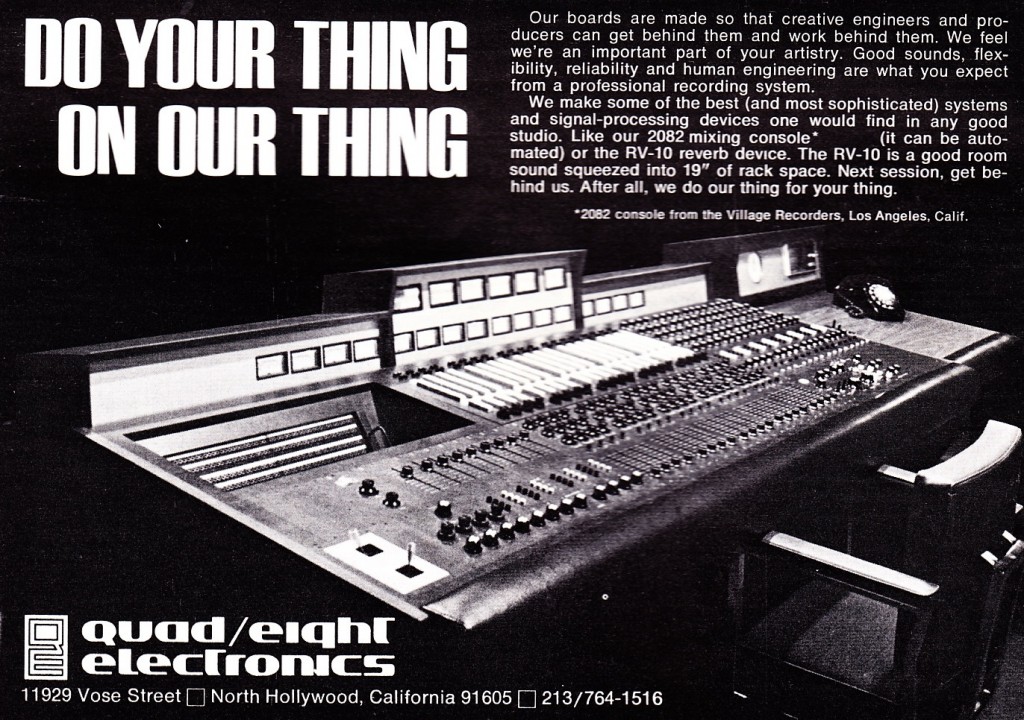 Above: Quad/eight 2082 console circa 1972
Above: Quad/eight 2082 console circa 1972
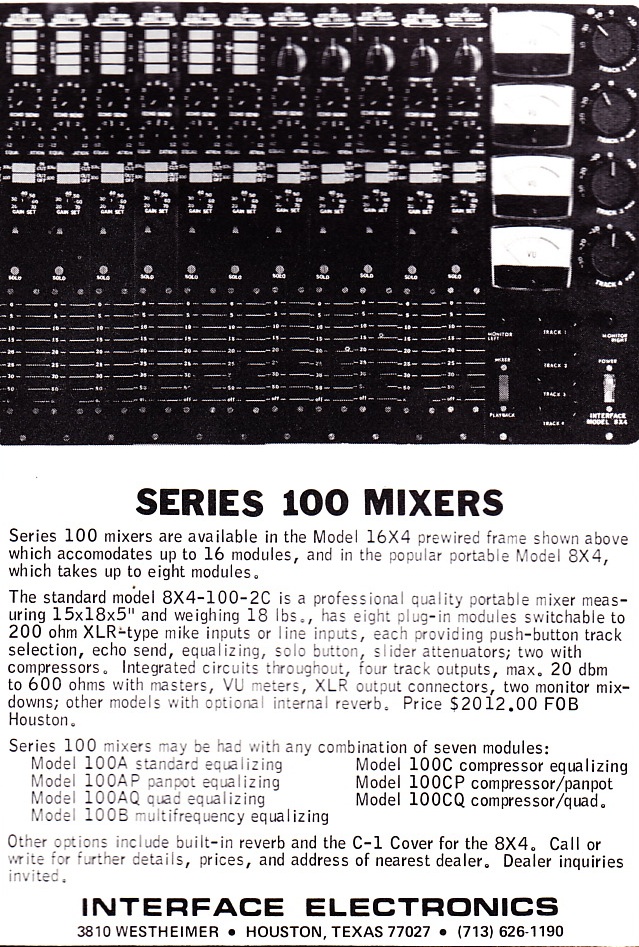 Above: Interface Electronics Series 100 console circa 1973
Above: Interface Electronics Series 100 console circa 1973
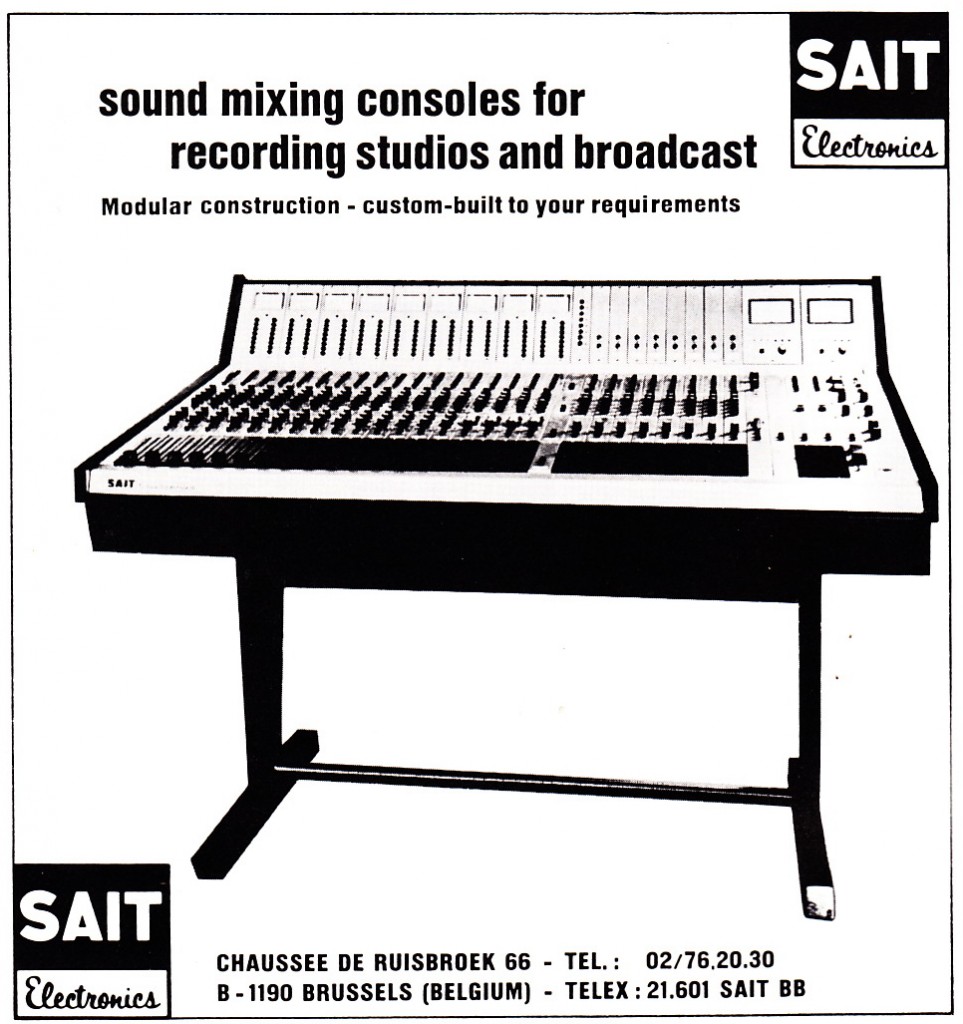 Above: Sait, a Belgium maker, offered this board in ’73
Above: Sait, a Belgium maker, offered this board in ’73
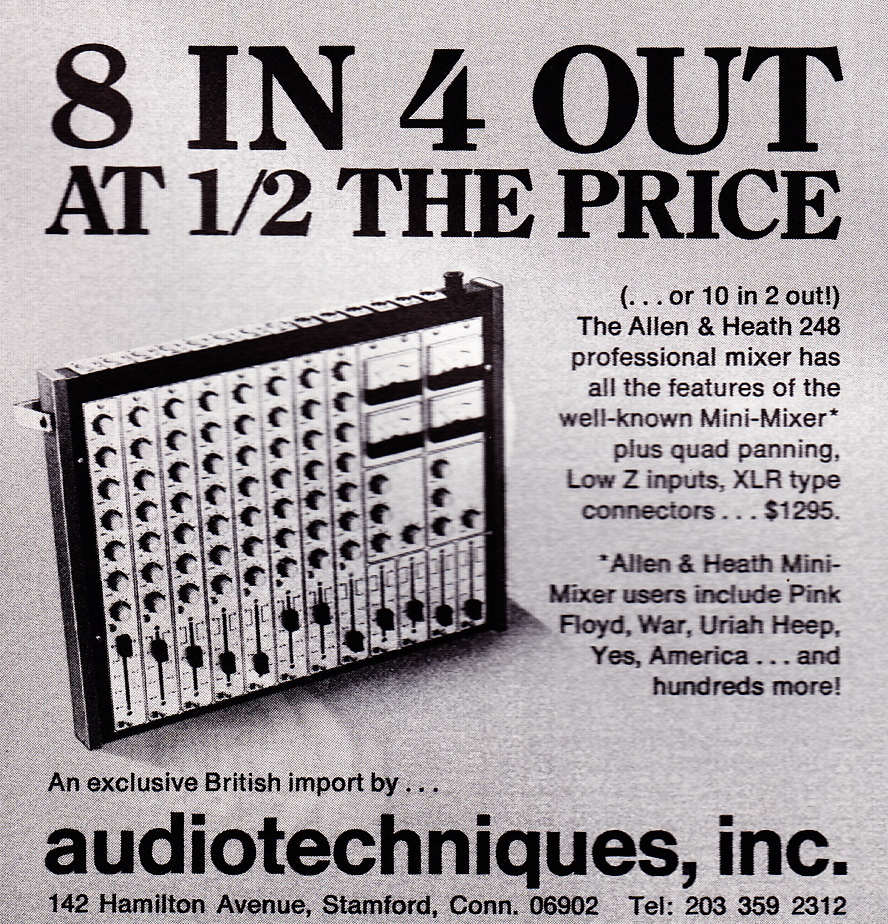 The Allen+Heath 248 portable mixer circa 1973
The Allen+Heath 248 portable mixer circa 1973
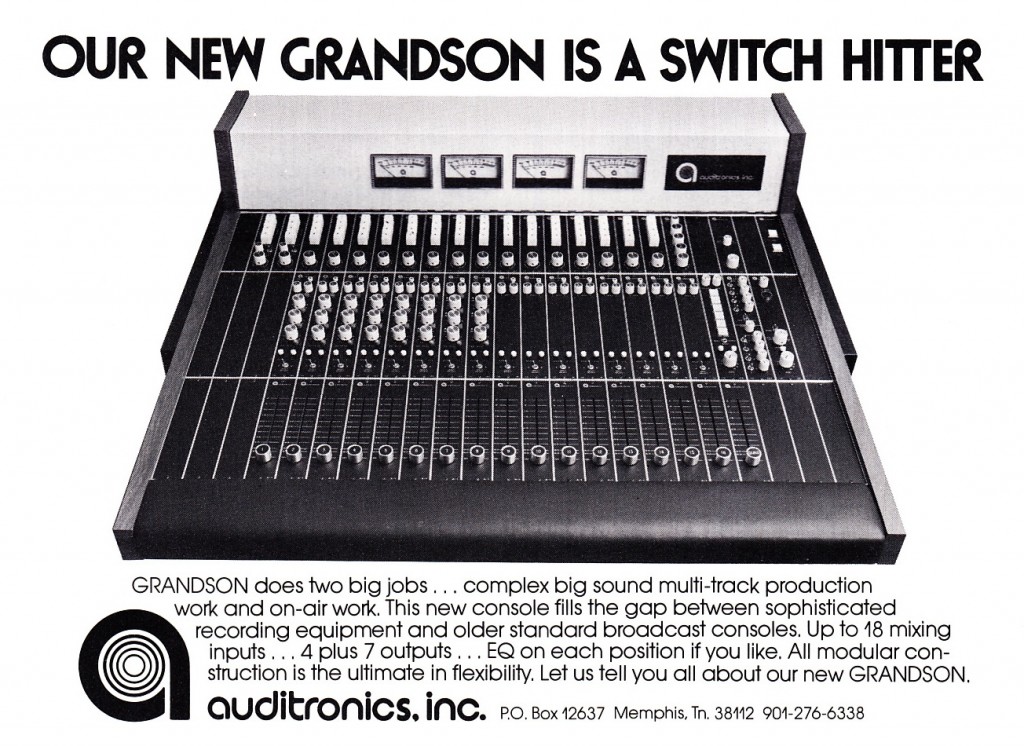 The earlier iteration of the Audiotronics Grandson, this one from 1973
The earlier iteration of the Audiotronics Grandson, this one from 1973
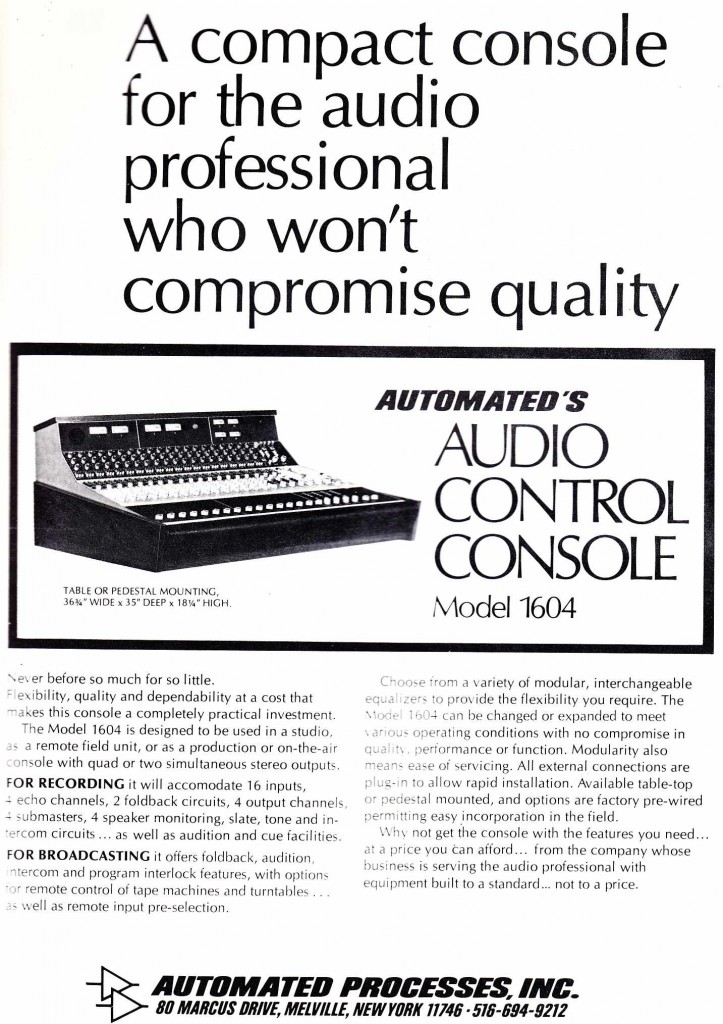 The API 1604 as-seen in 1974, and as still-seen in studios worldwide
The API 1604 as-seen in 1974, and as still-seen in studios worldwide
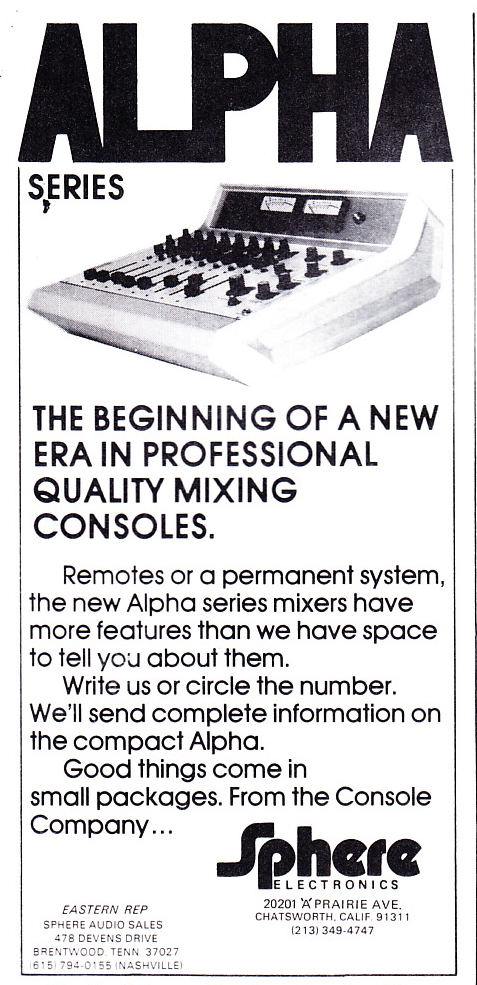 Sphere was a high-end console-maker that I know almost nothing about; here we see their ALPHA, a compact model from 1975
Sphere was a high-end console-maker that I know almost nothing about; here we see their ALPHA, a compact model from 1975
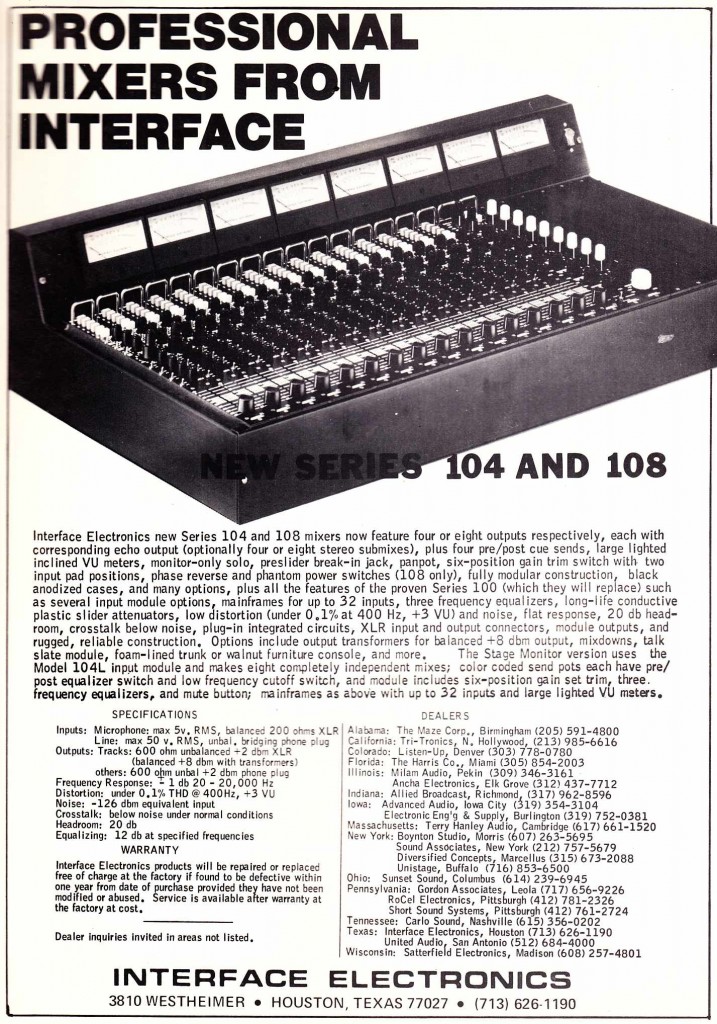 In 1976 Interface offered the 104 and 108 series consoles
In 1976 Interface offered the 104 and 108 series consoles
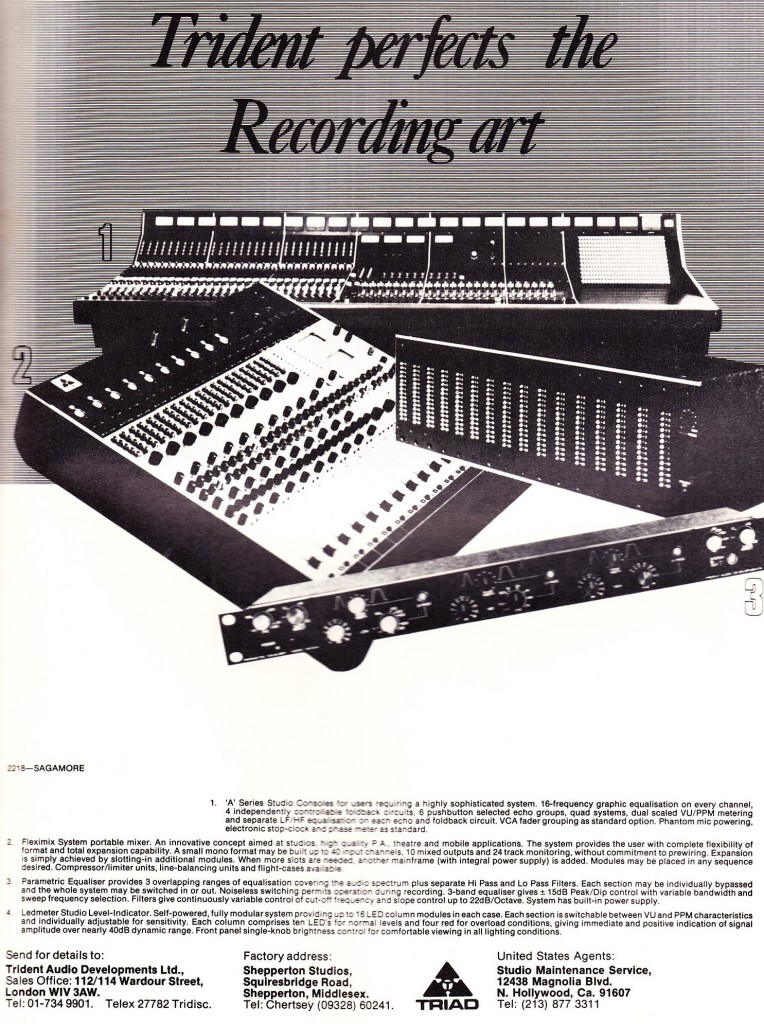 Above: the Trident range circa ’77. Apologies for the poor scan, I think I may need to invest in a new scanner. As I mentioned at the head, I learned on the Trident Trimix, which was a ‘portable’ unit (portable but still around 150lbs!) that was offered a bit later. I later learned the dark side of the Trimix is that… aside from the mic inputs, none of it is balanced and the signal-to-noise ratio is very poor. Which brings up a good point: before investing in one of these things, research the specs. What I hadn’t known then is that the Trimix was originally conceived of as a live console… designed especially for Queen, if I recall correctly…Anyhow, yes the EQ sounded amazing and the build quality was high but it was far too noisy for modern productions.
Above: the Trident range circa ’77. Apologies for the poor scan, I think I may need to invest in a new scanner. As I mentioned at the head, I learned on the Trident Trimix, which was a ‘portable’ unit (portable but still around 150lbs!) that was offered a bit later. I later learned the dark side of the Trimix is that… aside from the mic inputs, none of it is balanced and the signal-to-noise ratio is very poor. Which brings up a good point: before investing in one of these things, research the specs. What I hadn’t known then is that the Trimix was originally conceived of as a live console… designed especially for Queen, if I recall correctly…Anyhow, yes the EQ sounded amazing and the build quality was high but it was far too noisy for modern productions.
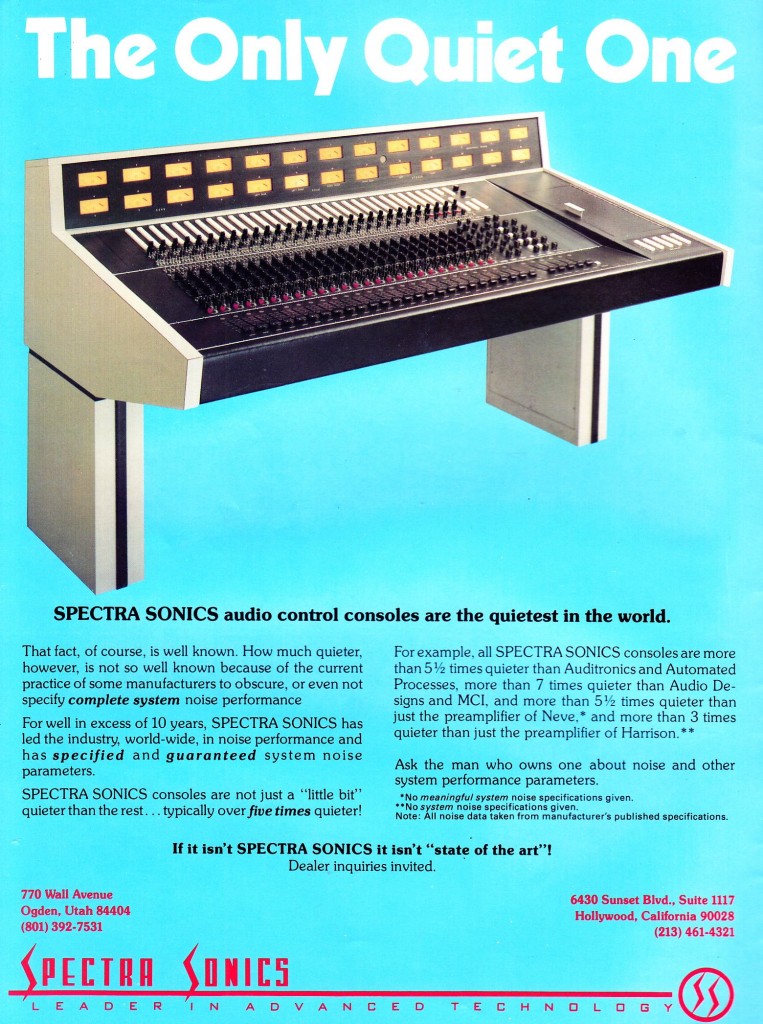 Above: Spectra Sonics console circa 1977.
Above: Spectra Sonics console circa 1977.
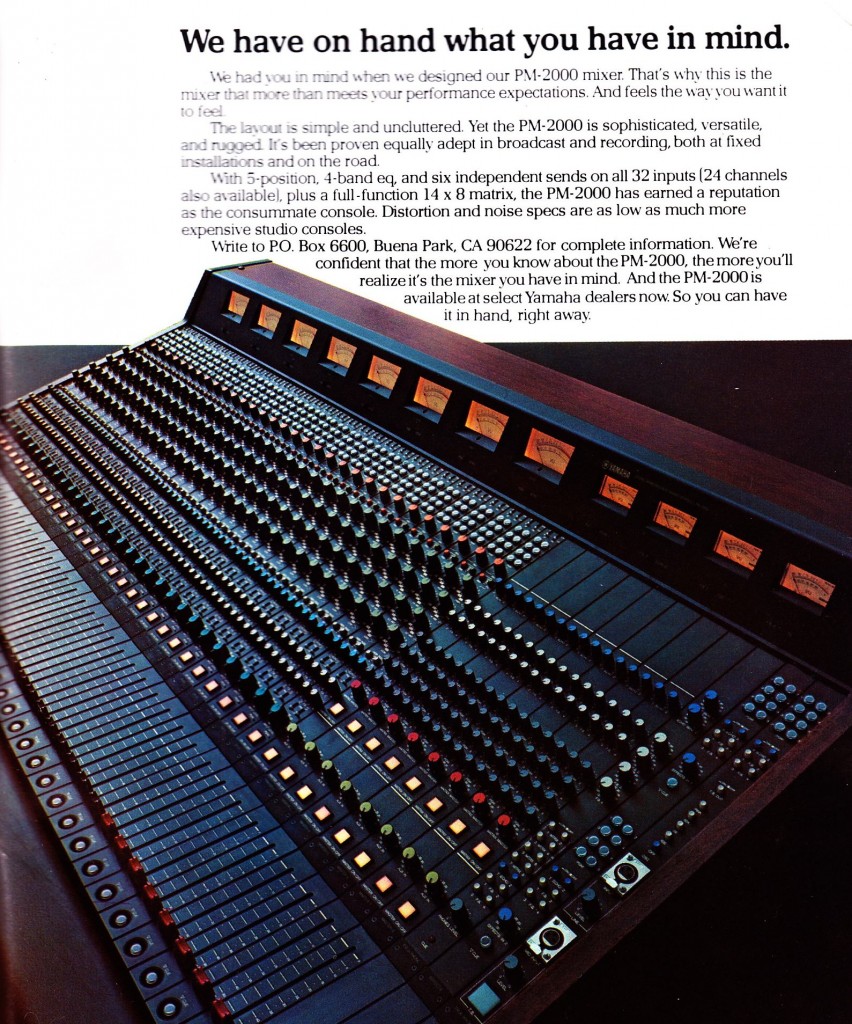 The Yamaha PM2000 of 1980, successor to the -“Japa-Neve” PM1000. And apparently even better? Weigh in…
The Yamaha PM2000 of 1980, successor to the -“Japa-Neve” PM1000. And apparently even better? Weigh in…
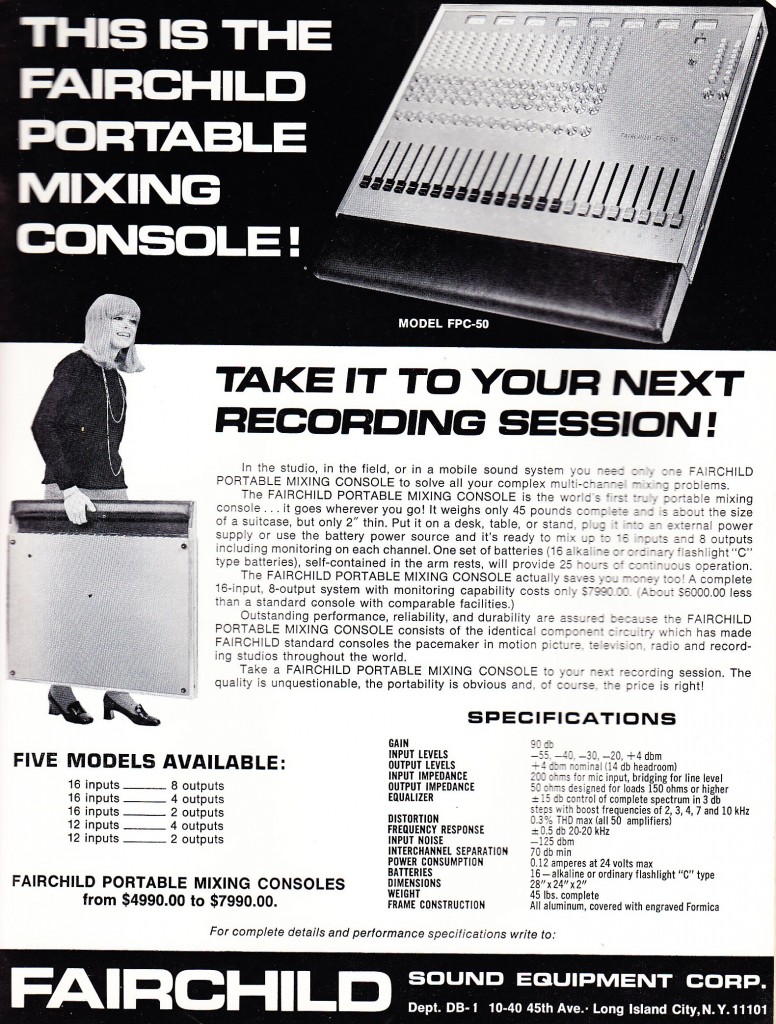 Here’s an unusual one: The Fairchild Portable Console of 1970, likely one their last pro-audio products. I have never seen one of these before. Anyone?
Here’s an unusual one: The Fairchild Portable Console of 1970, likely one their last pro-audio products. I have never seen one of these before. Anyone?
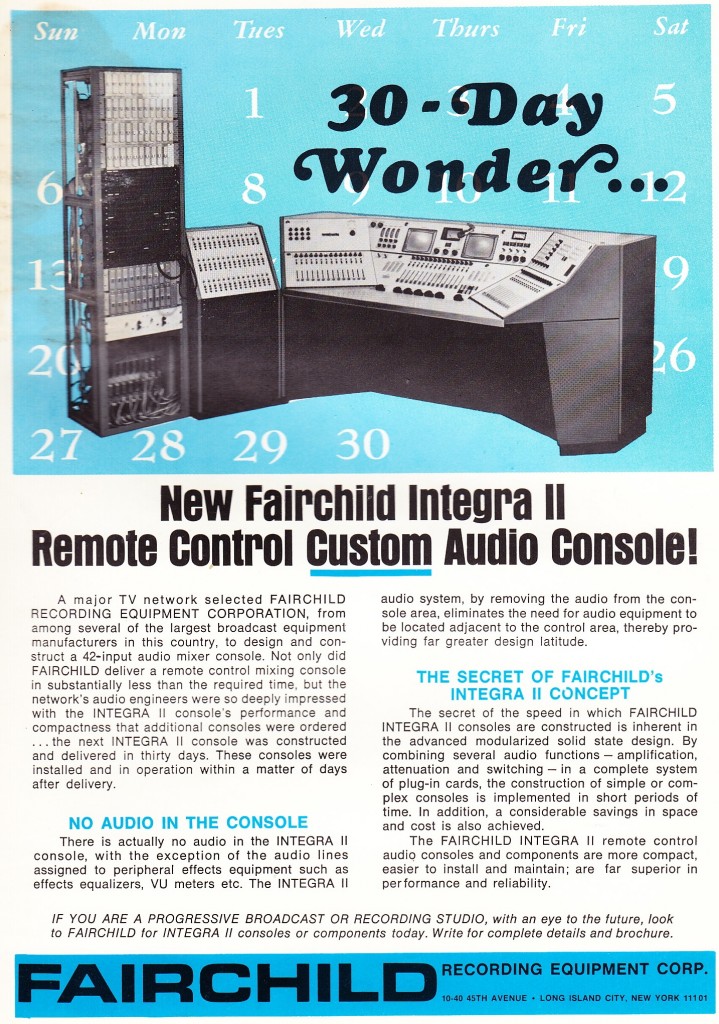 …and not quite the 70s, but… Fairchild introduces their INTEGRA console, 1968, with the bold notice “No Audio In The Console.” It’s pretty incredible how ahead of its time Fairchild was. Anyone ever use an INTEGRA? Did it sound good/work well? Bits and bobs from these monsters seem to surface on eBay all the time, but I doubt there is still a complete unit out there. Anyone?
…and not quite the 70s, but… Fairchild introduces their INTEGRA console, 1968, with the bold notice “No Audio In The Console.” It’s pretty incredible how ahead of its time Fairchild was. Anyone ever use an INTEGRA? Did it sound good/work well? Bits and bobs from these monsters seem to surface on eBay all the time, but I doubt there is still a complete unit out there. Anyone?
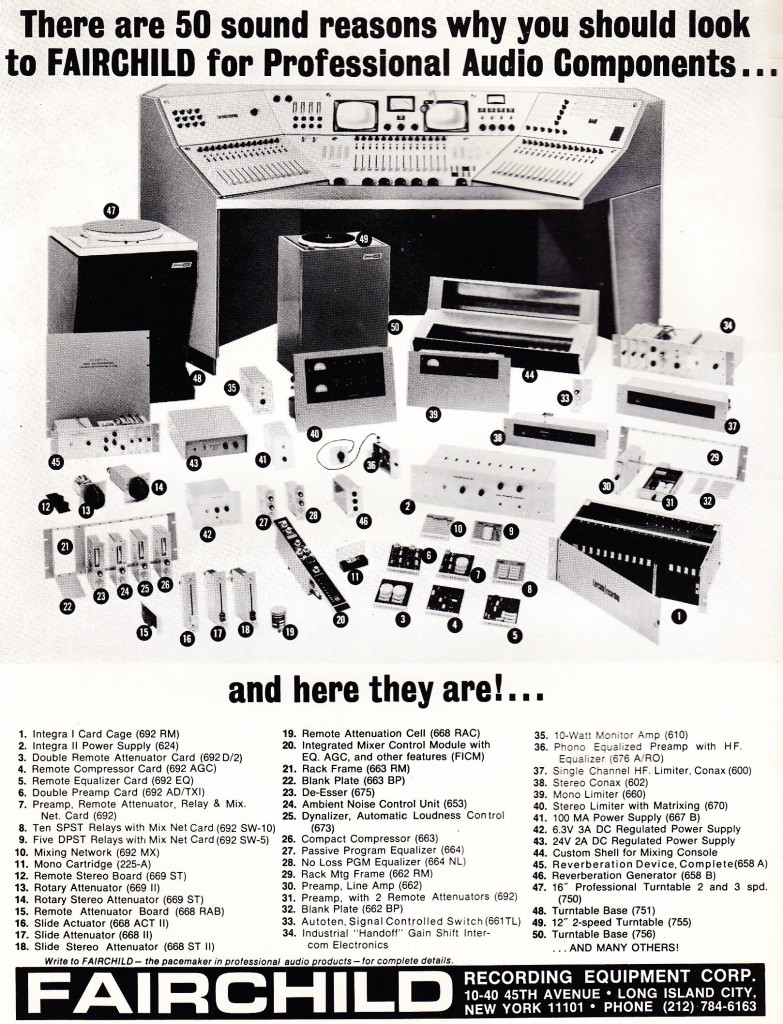 …and here’s a breakdown of all the aforementioned bits+bobs.
…and here’s a breakdown of all the aforementioned bits+bobs.
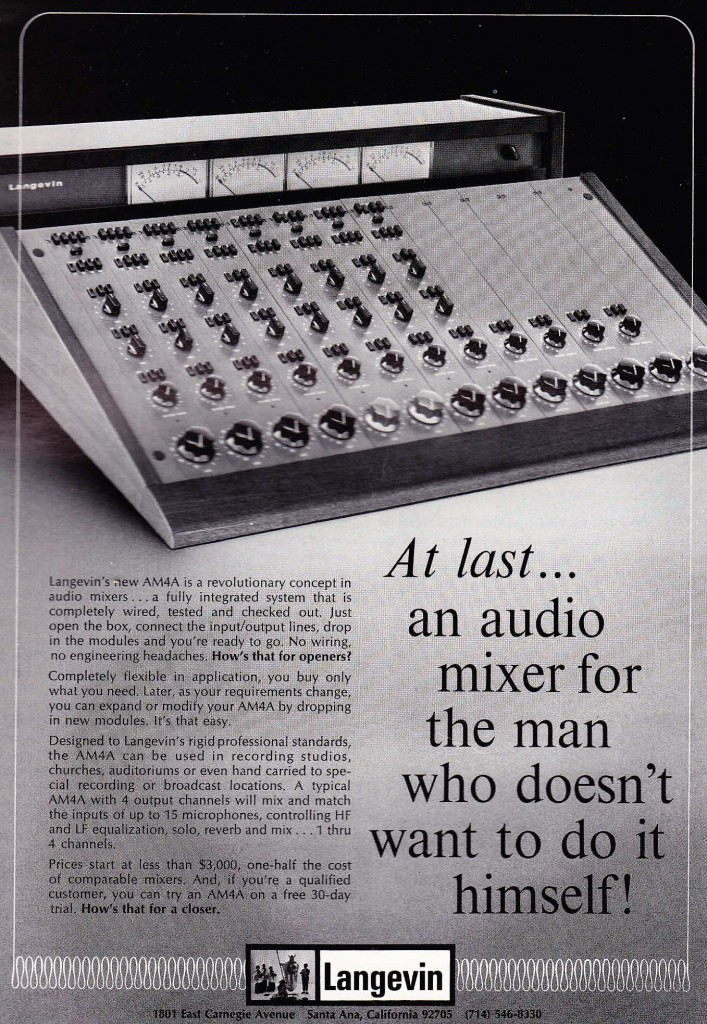 While all of the Fairchild Integras may have been carved up, the Langevin AM4A, certainly the opposite end of the technological spectrum, seems to have fared quite a bit better… I often see these on the market in the $10K range, and I have to admit I have often been tempted… Can any one tell us how these compare in terms of noise and response to a modern summing mixer? Anyone using these to mix thru?
While all of the Fairchild Integras may have been carved up, the Langevin AM4A, certainly the opposite end of the technological spectrum, seems to have fared quite a bit better… I often see these on the market in the $10K range, and I have to admit I have often been tempted… Can any one tell us how these compare in terms of noise and response to a modern summing mixer? Anyone using these to mix thru?
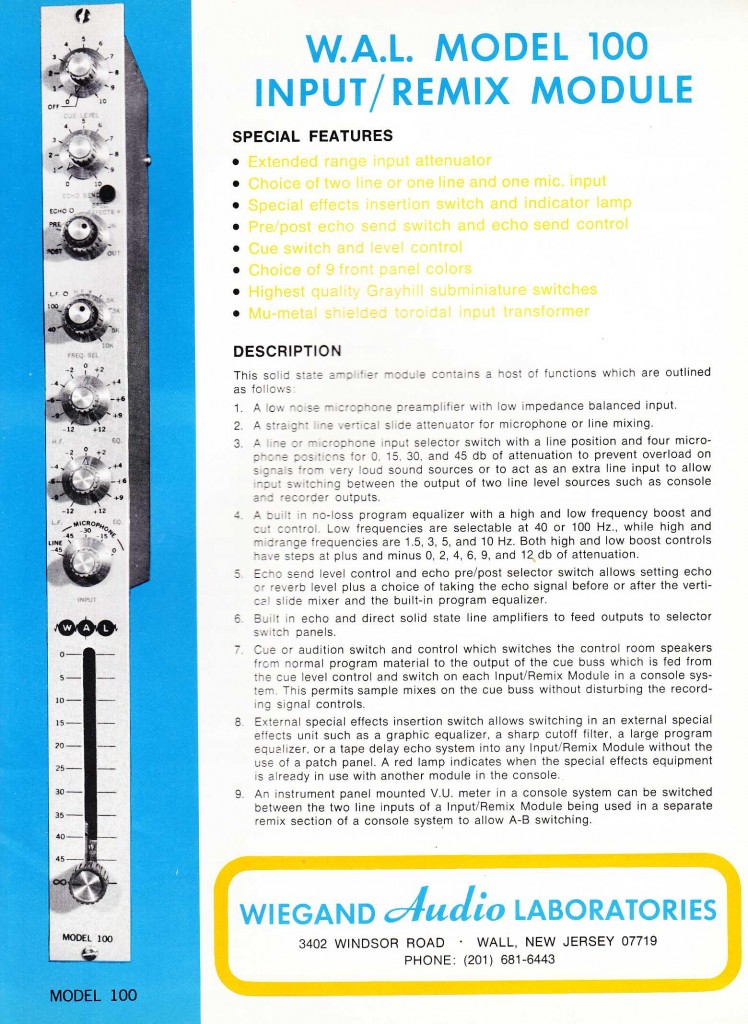 Wiegand Audio Labs offered their Model 100 channel strip in 1969
Wiegand Audio Labs offered their Model 100 channel strip in 1969
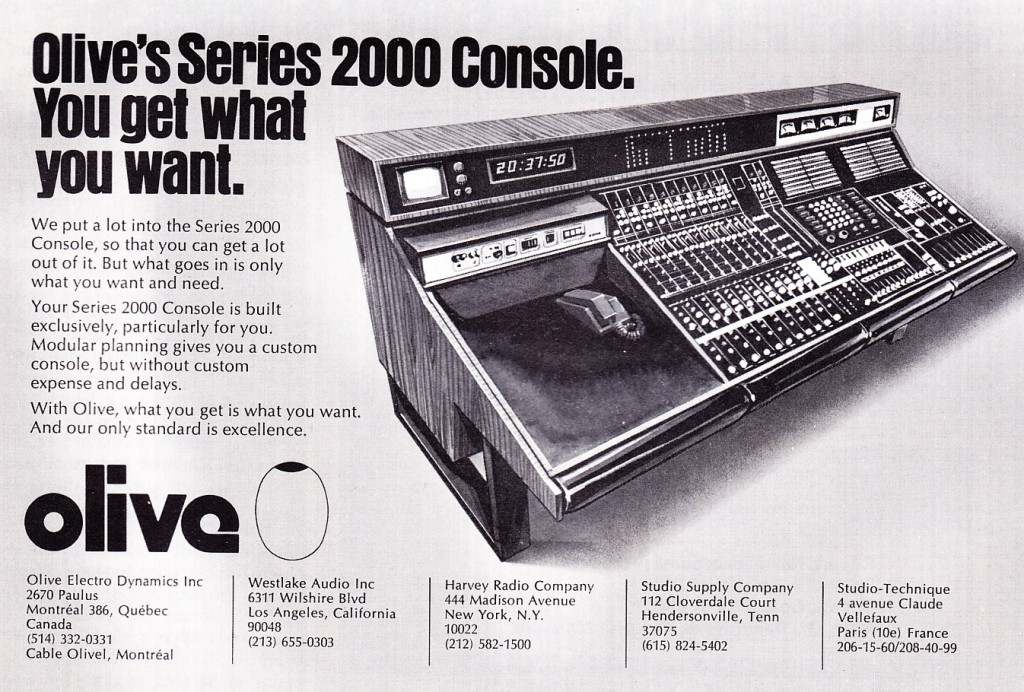 Montreal represent! I KNEW there had to be a Montreal maker of boards in the 70s… and sure enough, we find OLIVE. Here’s the Olive 2000 circa 1972. Seems lost-to-history… anyone?
Montreal represent! I KNEW there had to be a Montreal maker of boards in the 70s… and sure enough, we find OLIVE. Here’s the Olive 2000 circa 1972. Seems lost-to-history… anyone?
Much closer to Langevin than Fairchild, here we see the Altec 9300 circa 1970
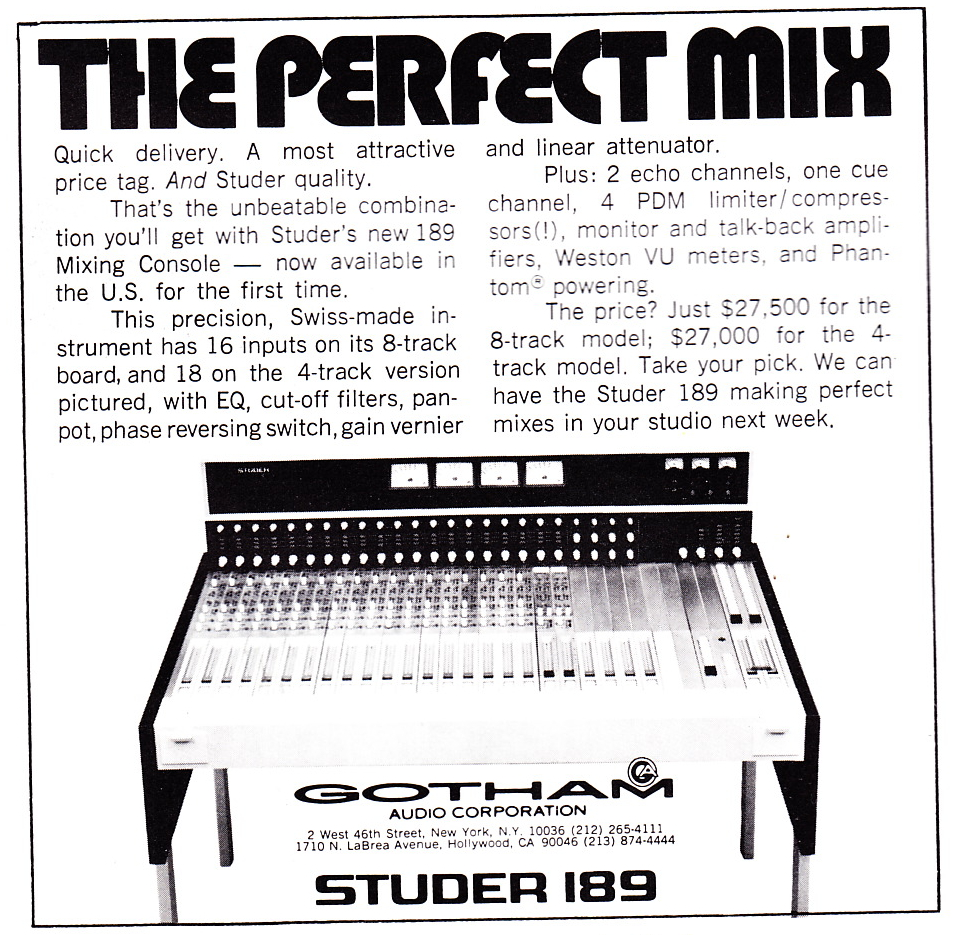 Above: Studer 189 circa 1972. Just $148,000 (no typo) 2013 dollars!
Above: Studer 189 circa 1972. Just $148,000 (no typo) 2013 dollars!
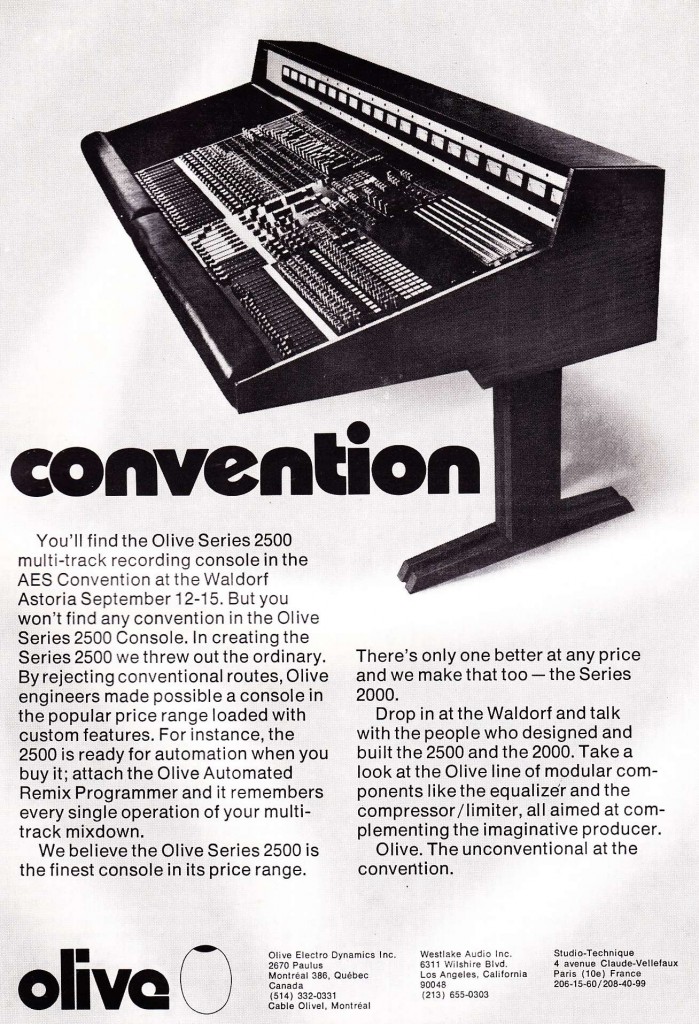 Olive also offered a 2500 model in 1972
Olive also offered a 2500 model in 1972
*************
*******
***
If any of y’all are actively using any of this stuff, write in and let the world know how they are in terms of sonics, reliability, and general utility. There is very, very little information online concerning some of these pieces, so you could end up being very helpful to some potential future user of these these machines…
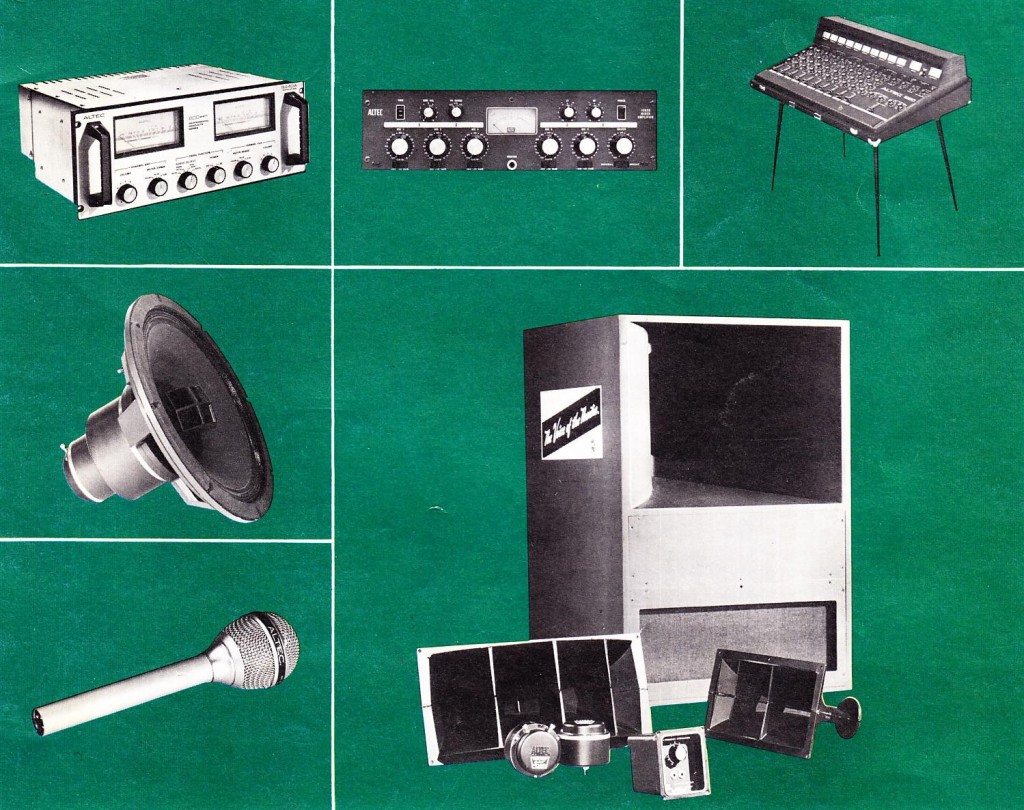 70’s months at P S DOT COM continues with a fresh scan of the complete 1976 Altec pro audio catalog, complete with pricelist. Presented in two parts due to file size.
70’s months at P S DOT COM continues with a fresh scan of the complete 1976 Altec pro audio catalog, complete with pricelist. Presented in two parts due to file size.
DOWNLOAD PART 1: Altec_1976_part1
DOWNLOAD PART 2: Altec_1976_part2
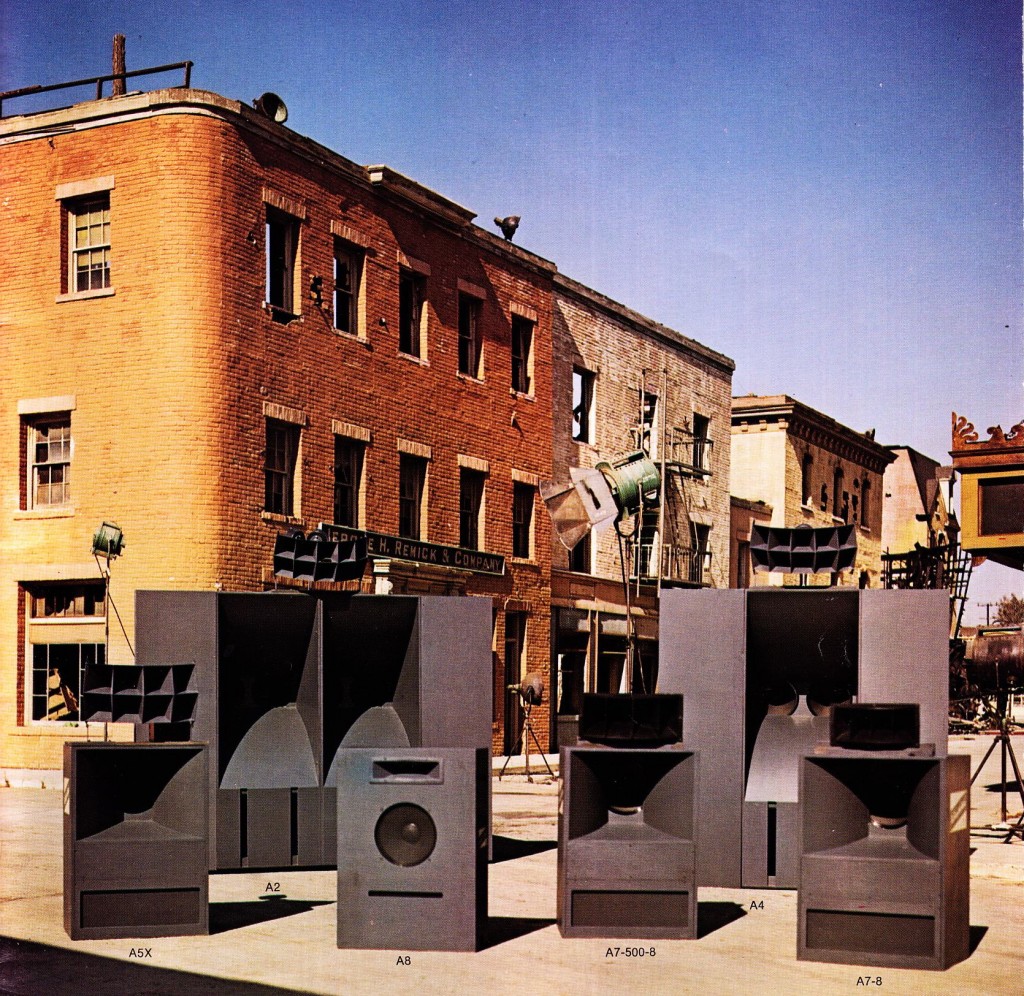 Above: Altec’s classic Cinema loudspeakers, including (LR) the 1,300lb A2 speaker.
Above: Altec’s classic Cinema loudspeakers, including (LR) the 1,300lb A2 speaker.
Products covered, with text, specs, and photos, include: Altec 1240B, 1208B, and 1218A ‘Voice of the Theatre’ speaker systems; 1221A stage monitor, 1219B speaker and 1224A Bi Amplifier, Altec A2, A4, A4X, A5X, A7-8, A7-500-8, and A-8 VOTT; Altec 9845A, 9844A, 814A, 849A, 210, 211A, 612C, 614D, 815A, 816A, and 828B speakers; 604-8G, 620-A, 9844, 9845A, 9849-8A, 9849-8D studio speakers, Altec 203B, 311-60, 311-90, 803B, 805B, 1003B, 1005B, 1505B, 32B, 511A, 511E, 31A, 511B, AND 811B horns; Altec 1211A and 1217A column loudspeakers; 417, 418, 421, and 425 musical instrument speaker; plus many many more speakers and speaker components. We also see the Altec 1220AC mono console, 351C, 1590C, 159B, 1594B, 9440A, 1224A, 1609A amplifiers and 1606A, 1607A, 1608A, and 1611A mixer/amps; Altec 1628A, 1592B, 1599A, and 1589A mixer/preamps; 1603 coupler, 1605A expander, 1612A compressor, 1650 EQ, 9430A digital delay (looks like a lexicon-made unit) and 9880A filter; a load of other bits and bobs, and microphones including the Altec 650, 654, 656, 655, 677, 676, 668, 699, M53, M54, 624, 626, and 687.